We finally got our high-end 2020 iMac with the 10-core CPU and the 5700XT graphics card late last week and now it’s time to put it through its paces, comparing it to everything from the iMac Pro, our $15,000 Mac Pro and of course, the high-end 16” MacBook Pro with the powerful 5600M graphics, which is what this article is all about.
We already compared the $2300 2020 iMac to the base 16” macBook Pro, and in that video, we compared things like the ports, the speakers, the displays, the convenience of portability with the MacBook, the microphones and the webcams, so definitely check out that article if you’re interested in those differences, but for this article, it’s all about performance, to help you decide which Mac is better for you!
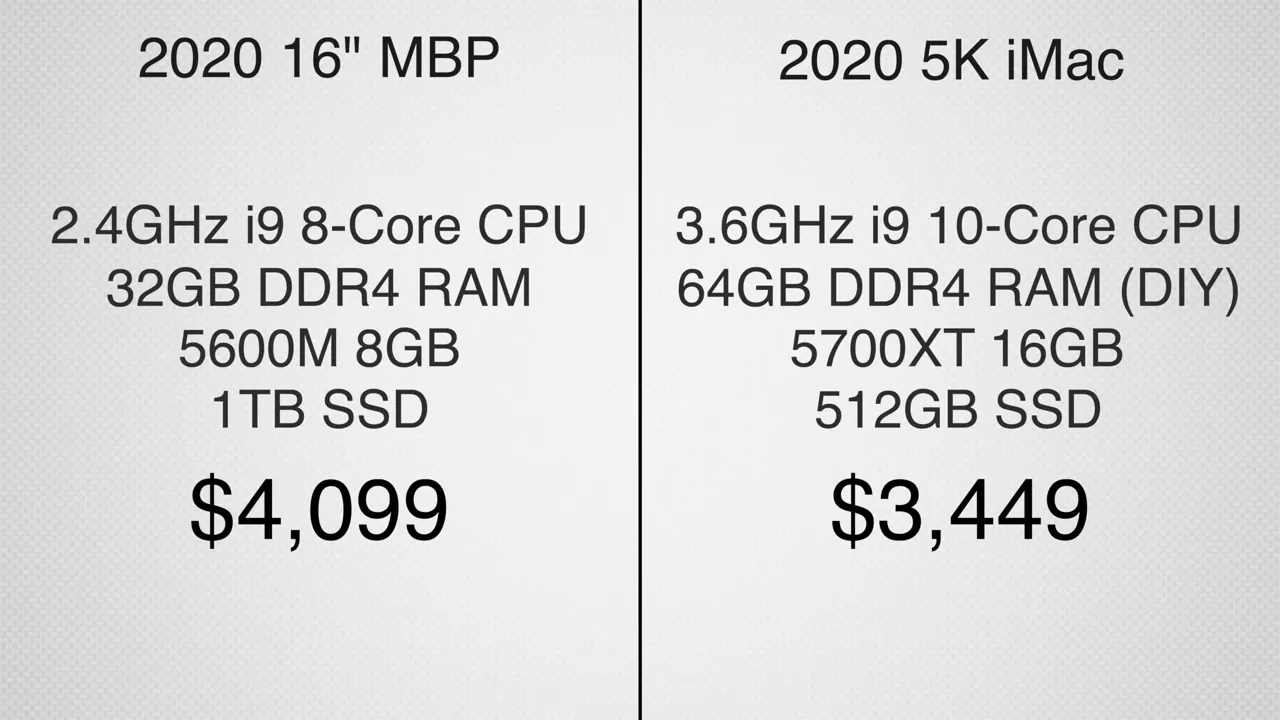 Here are the specs of both machines, and as you can see, the MacBook Pro is quite a bit more expensive, but it does come with a 1TB SSD which is a nice bonus, and on the other hand, we loaded the iMac up with 64GB of RAM for only $250 from Amazon since it’s so much cheaper than Apple’s $1,000 upgrade price, and it literally only takes a minute to do yourself. So if you end up choosing the iMac, absolutely upgrade the RAM yourself.
Here are the specs of both machines, and as you can see, the MacBook Pro is quite a bit more expensive, but it does come with a 1TB SSD which is a nice bonus, and on the other hand, we loaded the iMac up with 64GB of RAM for only $250 from Amazon since it’s so much cheaper than Apple’s $1,000 upgrade price, and it literally only takes a minute to do yourself. So if you end up choosing the iMac, absolutely upgrade the RAM yourself.
Before we get into the performance, I want to mention that the iMac benefits from a better cooling system, double the RAM, 2 more CPU cores and double the graphics VRAM, which runs at the same 394GB/s bandwidth as the super fast HBM2 in the 5600M graphics on the 16” MacBook Pro.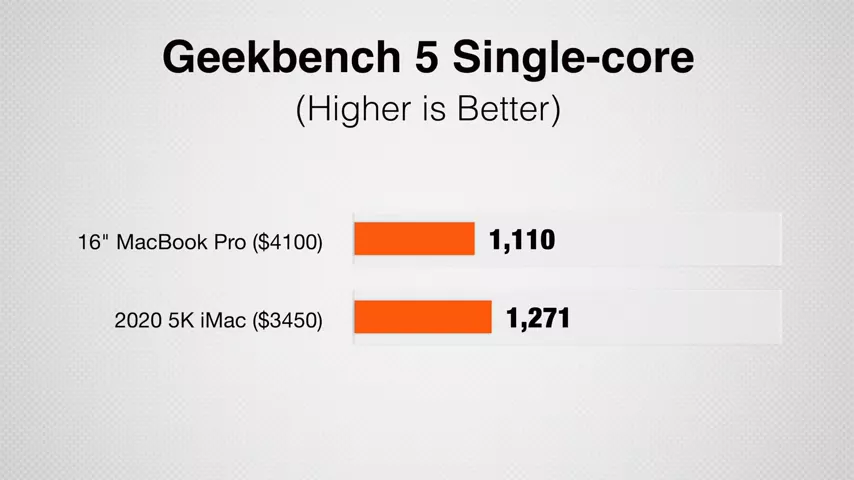 Starting with Geekbench 5’s CPU test, the iMac has about 15% more single-core performance, but a very impressive 32% higher multi-core score
Starting with Geekbench 5’s CPU test, the iMac has about 15% more single-core performance, but a very impressive 32% higher multi-core score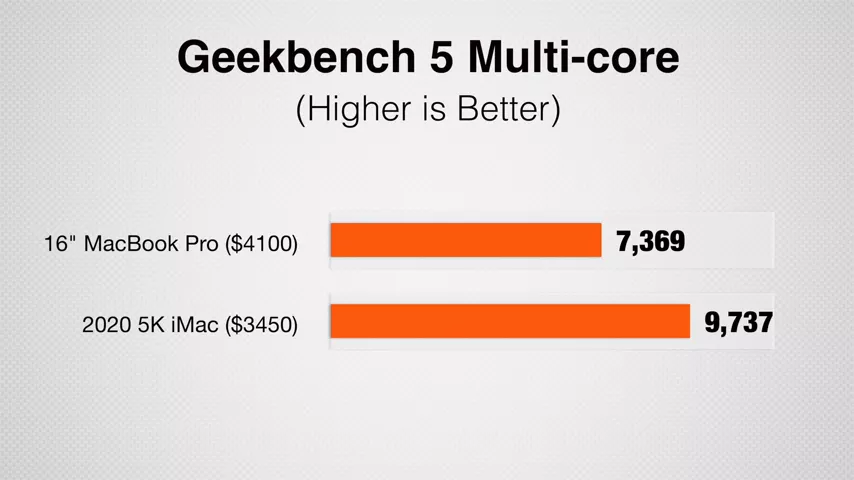 so it definitely has a huge advantage there, but that’s just Raw performance.
so it definitely has a huge advantage there, but that’s just Raw performance.
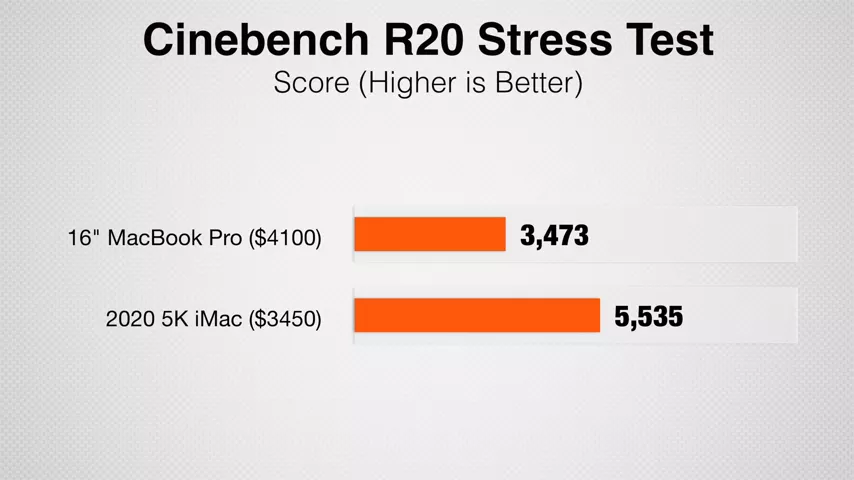 In the Cinebench R20 Stress Test, which factors in the cooling systems, there was an even bigger difference, with the iMac being a huge 60% more powerful, which shows the advantage of the much larger cooling system. So even though the iMac isn’t portable, that 60% difference in heavy workloads could be worth it to a lot of people.
In the Cinebench R20 Stress Test, which factors in the cooling systems, there was an even bigger difference, with the iMac being a huge 60% more powerful, which shows the advantage of the much larger cooling system. So even though the iMac isn’t portable, that 60% difference in heavy workloads could be worth it to a lot of people.
Moving onto graphics benchmarks, we tested raw graphics performance using Geekbench 5’s Metal test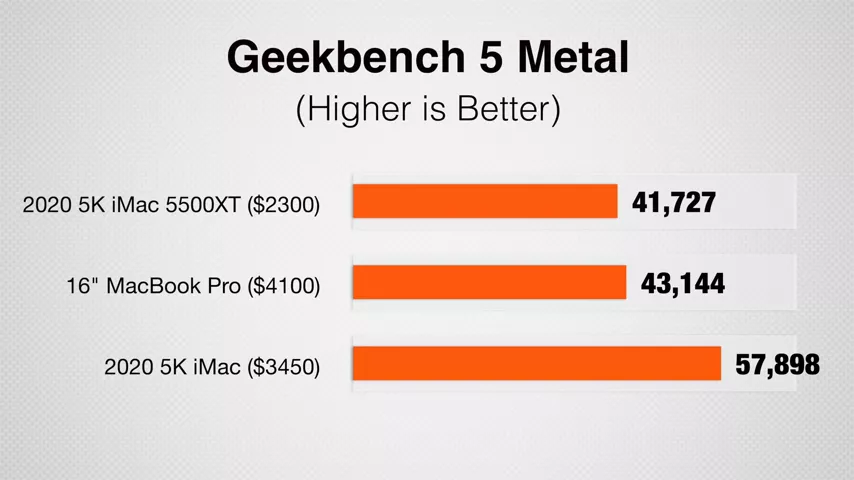 and the iMac’s 5700 XT was about 34% more powerful than the MacBooks 5600M, which is actually still impressive, being faster than the 5500XT card in the $2300 iMac.
and the iMac’s 5700 XT was about 34% more powerful than the MacBooks 5600M, which is actually still impressive, being faster than the 5500XT card in the $2300 iMac.
Moving onto gaming performance using Unigine’s Heaven benchmark on the extreme preset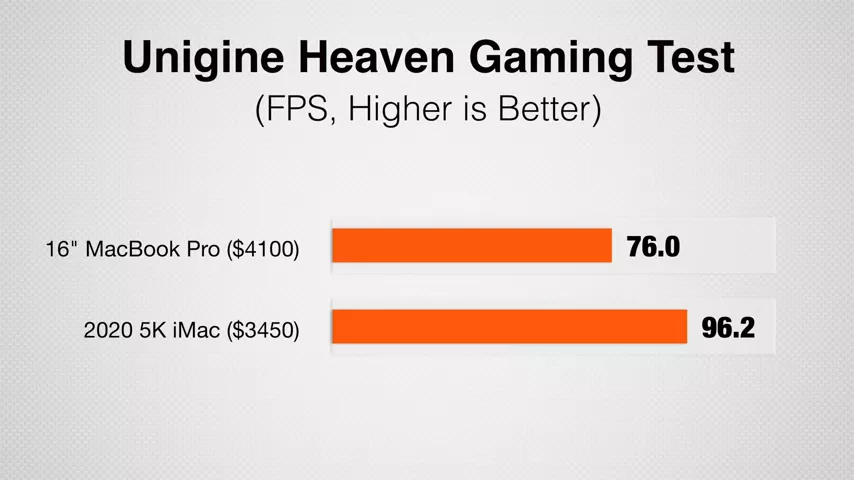 the iMac got around 20 more FPS, and it performed very well when we played a couple of games under Windows 10 using boot camp in our Gaming review of this iMac.
the iMac got around 20 more FPS, and it performed very well when we played a couple of games under Windows 10 using boot camp in our Gaming review of this iMac.
Since Ungine uses OpenGL, we also ran some Metal-based benchmarks using GFXBench Metal 5.0.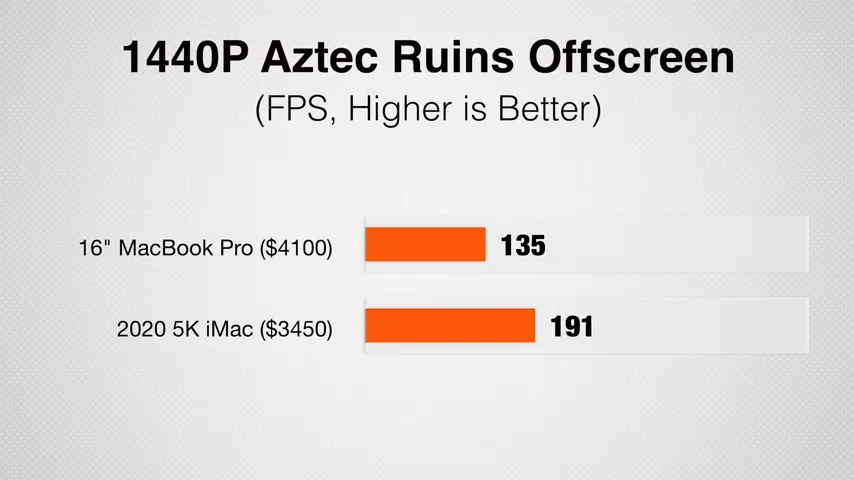 In the Aztec Ruins test, the iMac was actually 42% more powerful than the MacBook Pro, and in the Manhattan test
In the Aztec Ruins test, the iMac was actually 42% more powerful than the MacBook Pro, and in the Manhattan test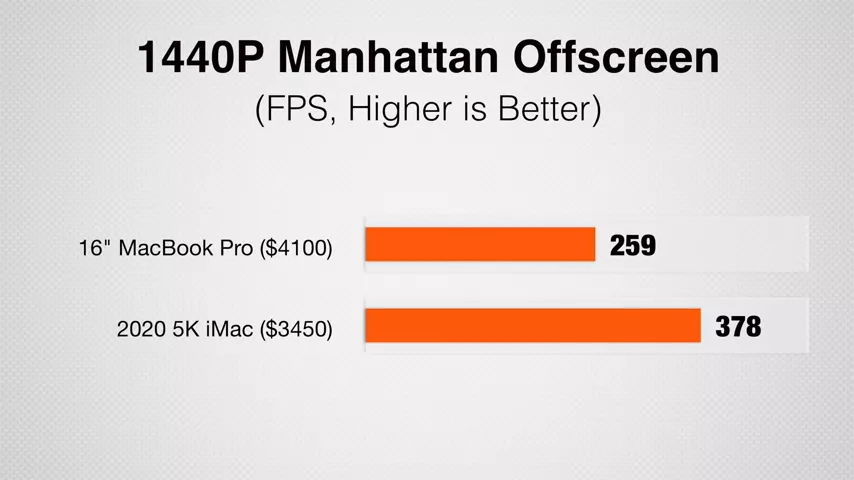 the iMac scored an even bigger 46% more than the 5600M in the MacBook, so it looks like it’s even better for Metal-based benchmarks.
the iMac scored an even bigger 46% more than the 5600M in the MacBook, so it looks like it’s even better for Metal-based benchmarks.
But, as we all know, benchmarks don’t tell us the full story, not at all, as you’re about to see in the real-world tests.
We’re gonna start off with testing photo editing performance using Lightroom Classic. 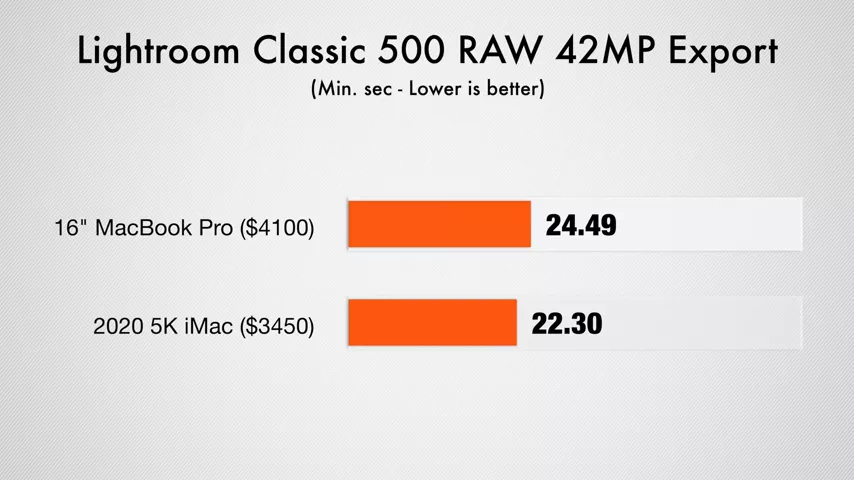 We exported 500 RAW 42MP photos on both machines and to our surprise, the MacBook Pro kept up very well, only taking a couple more minutes to export all of these photos, so while the iMac is faster for photo exporting, it’s not that big of a difference.
We exported 500 RAW 42MP photos on both machines and to our surprise, the MacBook Pro kept up very well, only taking a couple more minutes to export all of these photos, so while the iMac is faster for photo exporting, it’s not that big of a difference.
Our Macbook Pro is loaded with 32GB of RAM, and that’s incredibly important for photo editing as we discovered in our How much RAM do you need for Macs in 2020 article. We used the iMac, and by simply going from 16GB to 32GB saved us over 4 minutes in this test, so it seems like RAM is the most important factor for photo editing.
Before we get into video editing with Final Cut Pro X, where we saw the most surprising results, let’s show off the results from the New Logic Pro X benchmark for music producers. 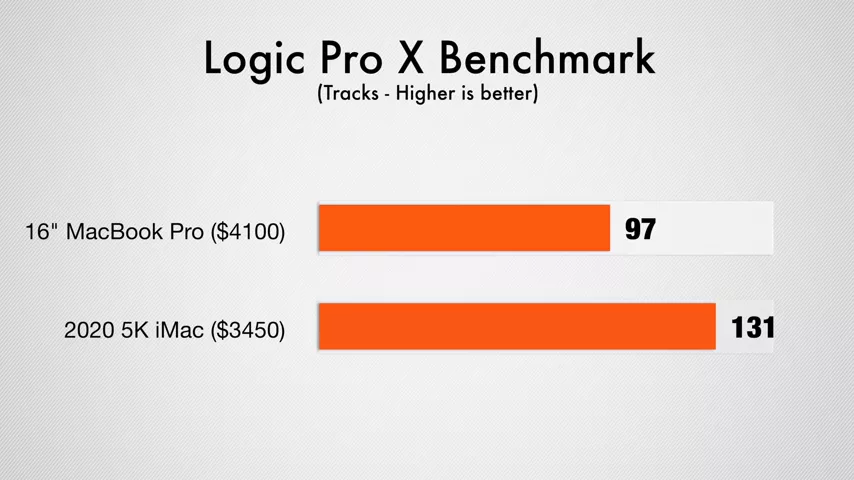 The high-end iMac with the 10-core CPU was able to handle a pretty impressive 131 tracks being played at the same time, compared to 97 tracks with the MacBook Pro, that’s 35% more performance for music production.
The high-end iMac with the 10-core CPU was able to handle a pretty impressive 131 tracks being played at the same time, compared to 97 tracks with the MacBook Pro, that’s 35% more performance for music production.
We also tested one of the older versions of Blender which used the graphics to render the bmw and classroom tests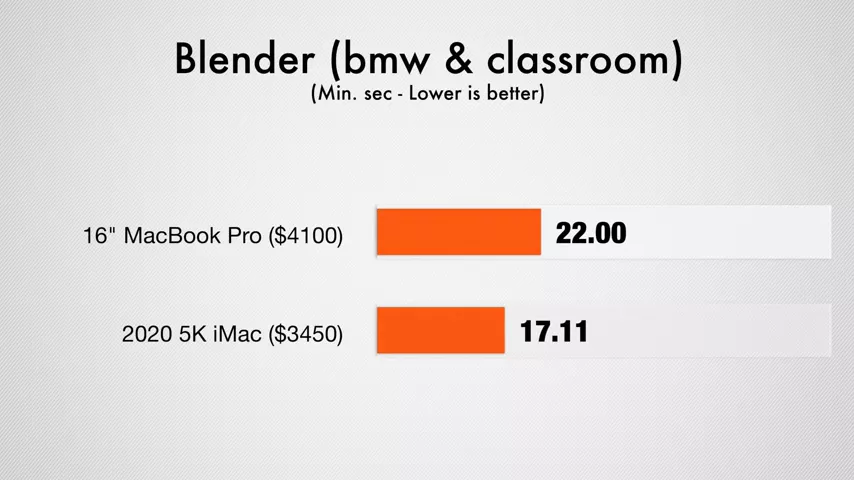 and the iMac finished about 5 minutes quicker, which we think benefits from running at higher clock speeds.
and the iMac finished about 5 minutes quicker, which we think benefits from running at higher clock speeds.
Let’s finally get into video editing starting with the Bruce X 5K benchmark in Final Cut Pro X. 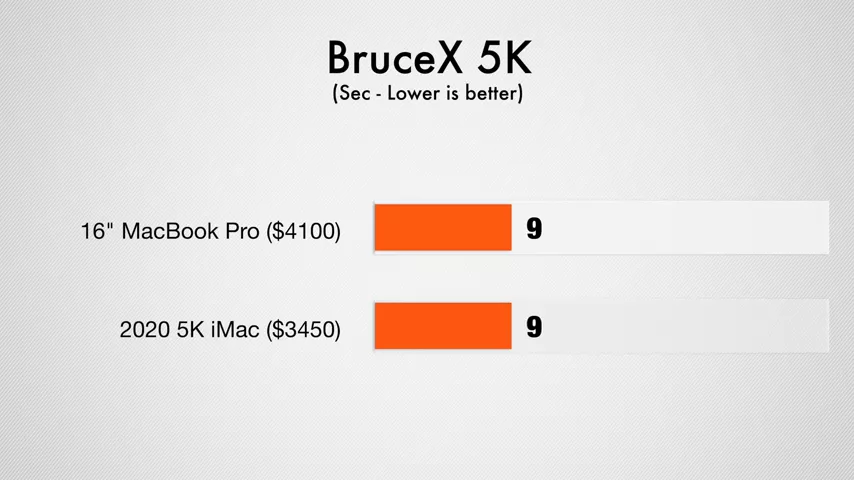 Here, it was surprising to see that there was literally no difference at all. The MacBook Pro was able to finish the test in the exact same 9 seconds, possibly due to the HBM2 memory.
Here, it was surprising to see that there was literally no difference at all. The MacBook Pro was able to finish the test in the exact same 9 seconds, possibly due to the HBM2 memory. 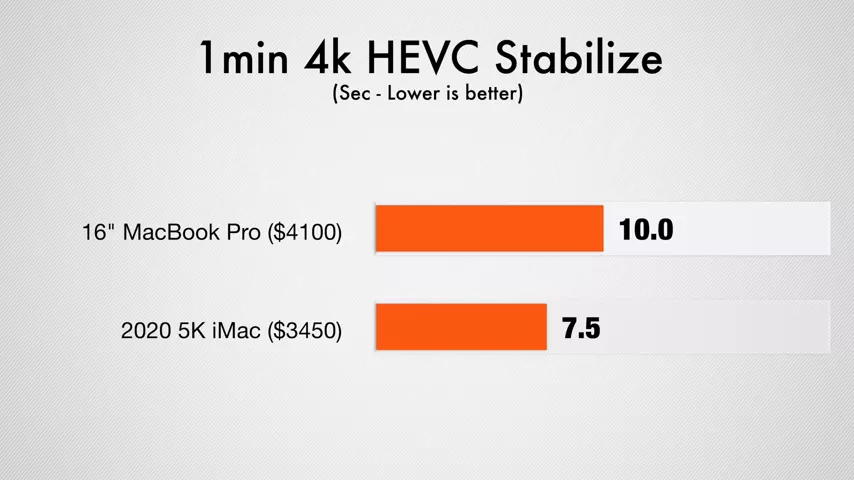 And then moving onto our 1 minute 4K HEVC stabilization test, the iMac finished around 2 and a half seconds faster, which doesn’t sound like much, but it’s a 25% improvement which could add up over time.
And then moving onto our 1 minute 4K HEVC stabilization test, the iMac finished around 2 and a half seconds faster, which doesn’t sound like much, but it’s a 25% improvement which could add up over time.
Moving onto our export tests, we exported a 5minute 4K H.264 clip with added effects, which is the most common format that youtubers use, and to our surprise, the 16” MacBook Pro actually finished a couple of seconds faster. 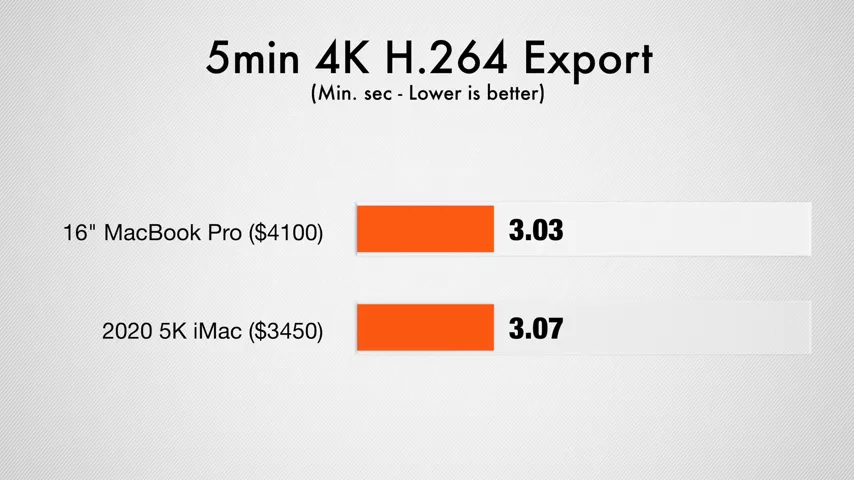 The main reason for that is because both machines aren’t limited by the CPU or the graphics in this specific test, they’re actually both using the same integrated UHD graphics 630 chip with Quicksync technology to encode, so that small difference might be due to the 5700XT not being quite as optimized.
The main reason for that is because both machines aren’t limited by the CPU or the graphics in this specific test, they’re actually both using the same integrated UHD graphics 630 chip with Quicksync technology to encode, so that small difference might be due to the 5700XT not being quite as optimized. 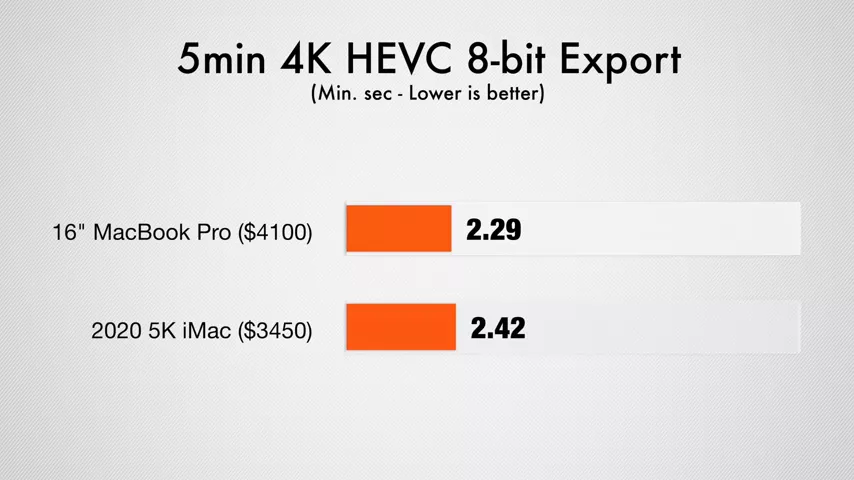 Exporting a 5minute HEVC clip, the iMac is surprisingly slower, once again, by 13 seconds this time, which is a bit disappointing considering the huge difference in raw performance we saw earlier. But this test is also not dependent on raw performance, HEVC footage is actually taken care of by Apple’s T2 chip and the hardware accelerators in the Navi-based graphics.
Exporting a 5minute HEVC clip, the iMac is surprisingly slower, once again, by 13 seconds this time, which is a bit disappointing considering the huge difference in raw performance we saw earlier. But this test is also not dependent on raw performance, HEVC footage is actually taken care of by Apple’s T2 chip and the hardware accelerators in the Navi-based graphics.
The important thing to note is that last year’s iMac that lacked both of those things took MUCH longer in this test, over 6 minutes compared to the new 2 minute and 42 second time, so it’s definitely a huge improvement. But as for why the iMac is slower than the MacBook, we think it’s because the iMac is incorrectly using Quick Sync to export instead of using the T2 chip like the MacBook Pro is using, so it seems like Final Cut is still telling the iMac to use Quicksync for this codec, since last year’s iMac didn’t have those hardware accelerators. But we’re expecting Final Cut Pro to be updated very soon to start using the Navi-based accelerators that can encode 8bit HEVC at up to 90 frames per second instead of 60 using Quicksync, so the iMac should either match the MacBook Pro or outperform it when that update gets released.
Finally moving onto some heavier RAW codecs, this is where the iMac starts to shine. In the 5 minute C200 RAW export test, the iMac finished over a minute faster because this test is very graphics dependent, which gives the iMac an advantage. 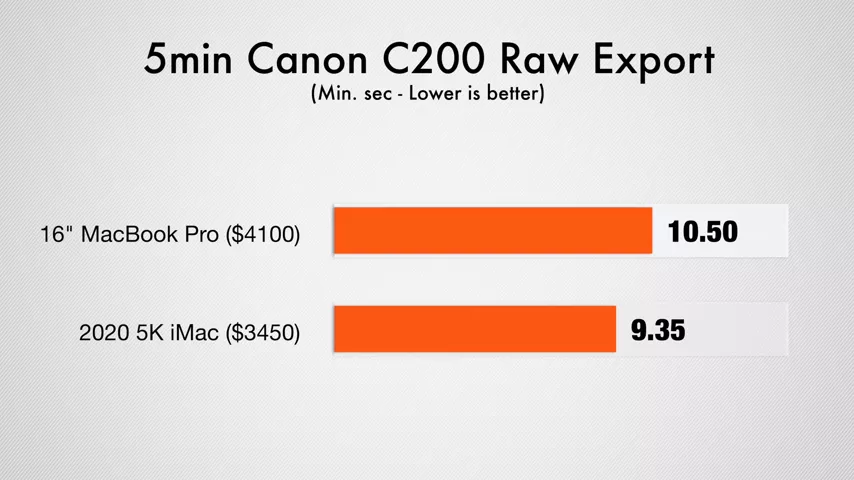 But then moving onto exporting a 5 minute 4.5K RED RAW clip, the iMac blows the MacBook Pro out of the water because this codec is dependent on both the CPU and graphics power.
But then moving onto exporting a 5 minute 4.5K RED RAW clip, the iMac blows the MacBook Pro out of the water because this codec is dependent on both the CPU and graphics power.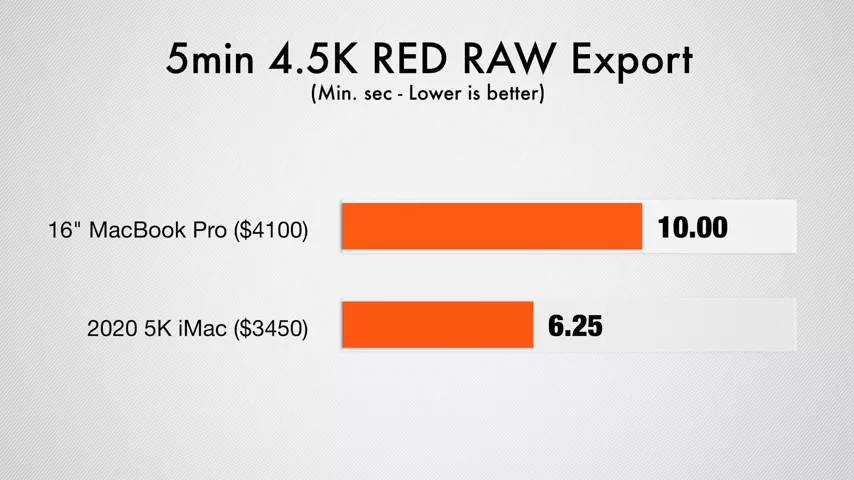 And then exporting a 1 minute 8K R3D Raw clip, we see an even bigger difference
And then exporting a 1 minute 8K R3D Raw clip, we see an even bigger difference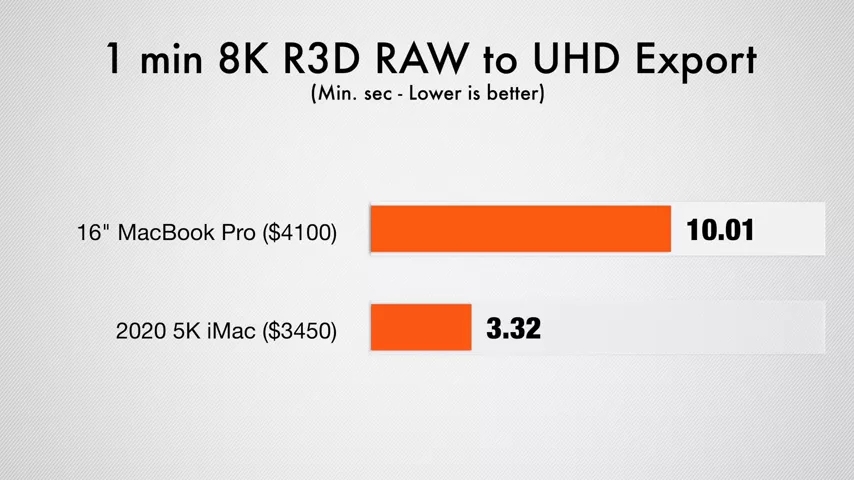 with the iMac finishing almost 3 times as fast as the MacBook Pro, which could be due to the fact that this codec is tough on VRAM, and the iMac has 16GB of memory compared to 8GB on the MacBook Pro.
with the iMac finishing almost 3 times as fast as the MacBook Pro, which could be due to the fact that this codec is tough on VRAM, and the iMac has 16GB of memory compared to 8GB on the MacBook Pro.
We also decided to run a couple of video editing tests in Davinci Resolve 16 Studio, starting with a Blackmagic RAW 6K to 4K export test. 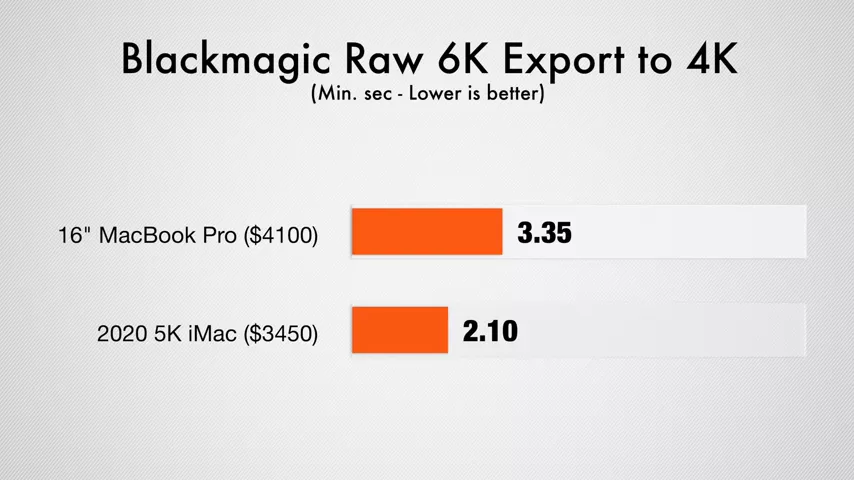 Here, the iMac Pro blew the Macbook Pro out of the water, finishing over a minute quicker which is huge for that codec. And the reason why is because this footage is very heavily dependent on graphics and VRAM. With the MacBook Pro, we noticed that while running this test, the 8GB of VRAM was completely maxed out
Here, the iMac Pro blew the Macbook Pro out of the water, finishing over a minute quicker which is huge for that codec. And the reason why is because this footage is very heavily dependent on graphics and VRAM. With the MacBook Pro, we noticed that while running this test, the 8GB of VRAM was completely maxed out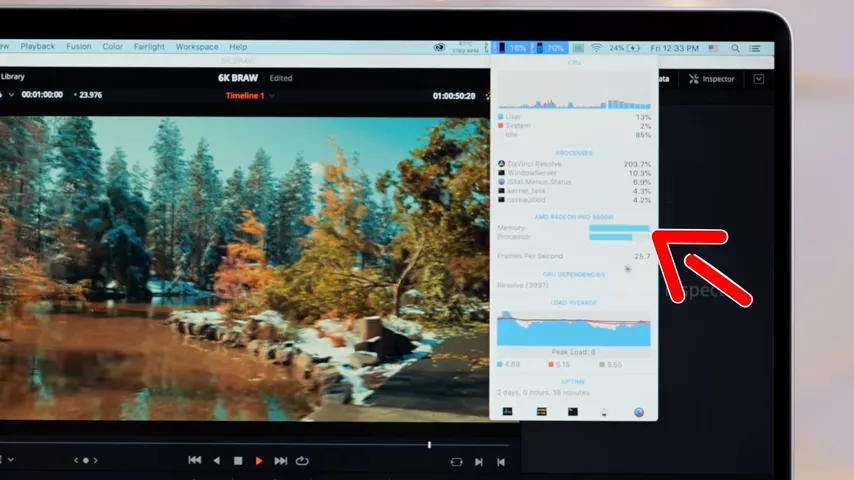 and that was actually the major bottleneck, so the 16GB of VRAM on the iMacs 5700XT graphics allowed it to finish this test much quicker.
and that was actually the major bottleneck, so the 16GB of VRAM on the iMacs 5700XT graphics allowed it to finish this test much quicker.
Moving onto our final test, temporal & spacial noise reduction using blackmagic raw footage. 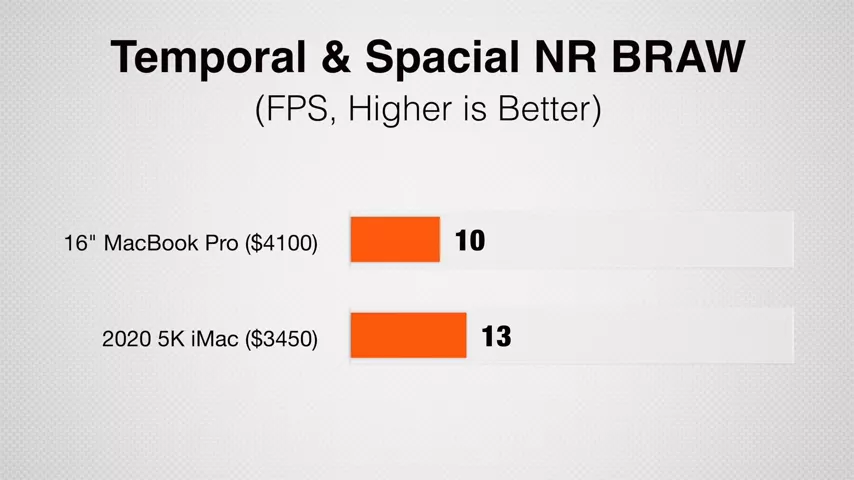 Here, we basically see a 30% improvement for the iMac, which basically matches up to the 34% improvement in raw graphics power that we use in Geekbench 5’s metal test.
Here, we basically see a 30% improvement for the iMac, which basically matches up to the 34% improvement in raw graphics power that we use in Geekbench 5’s metal test.
So now with all of those tests out of the way, let’s finish up with some conclusions we can pull from all of these tests, before we get into recommending which Mac you should be buying. We were surprised by how well the MacBook Pro kept up with the iMac and even beat it in some video editing tests. This is mainly because of that high end super fast 5600M graphics, and if Apple didn’t just release it and we were instead testing with the previous best 5500M graphics, then the iMac would have smoked it. The 5600M uses basically the same 40 core graphics chip as the 5700XT, but it’s simply running on less watts compared to the iMac which isn’t battery-powered. There were mainly two things that caused the iMac to perform much better in some of these tests, one of them was the fact that the 5700XT graphics card has 16GB of VRAM, which we noticed was a bottleneck in a lot of the heavier tests, especially for certain RAW codecs.
But keep in mind that only the 5700 XT option on the 2020 iMac has 16gigs of VRAM, all of the other options have 8GB of memory or less which will be slower than the MacBook Pro in most tests. Now the second thing was the drastic difference in processing power with that 10-core CPU, coupled with the much better cooling system that allows it to keep the clock speeds higher than on the Macbook Pro. Both of those things made a huge difference for heavy-hitting codecs like RAW footage, so the iMac is obviously the much better choice for things like that if you’re looking purely at performance differences, especially since the iMac is actually quite a bit cheaper than the 5600M MacBook Pro.
However, the MacBook also packs the same T2 chip and Navi-based hardware accelerators as the iMac, which allow it to perform the same or even slightly better than the iMac for lower-end work, like regular 4K h.264 editing or dealing with 4K HEVC footage, which is becoming increasingly more common. So if you’re just doing basic 4K editing and you’re not dealing with heavy RAW codecs, the MacBook Pro is actually a great choice and the same thing goes for Photo editors where the performance difference was surprisingly small.
Let’s finish up with the models we recommend for you guys. If you think you’d enjoy the portability of the MacBook Pro, then just buy the MacBook Pro because it still performs quite well compared to this new high-end iMac, especially for common video editing tasks and things like photo editing. But if you want the most performance for the least amount of cash, the iMac is gonna be the much better choice since you can upgrade the RAM yourself and save around $550 compared to that high-end MacBook Pro and have a much larger display. And then you end up getting much better performance for higher-end codecs like RAW footage, you’ll get better performance for Logic Pro X music production, you’ll get that 16GB of VRAM for things like 3D rendering, you’ll get quite a bit better gaming performance, and I’m fairly certain that performance should improve for common tasks when the iMac gets optimized as time goes on.
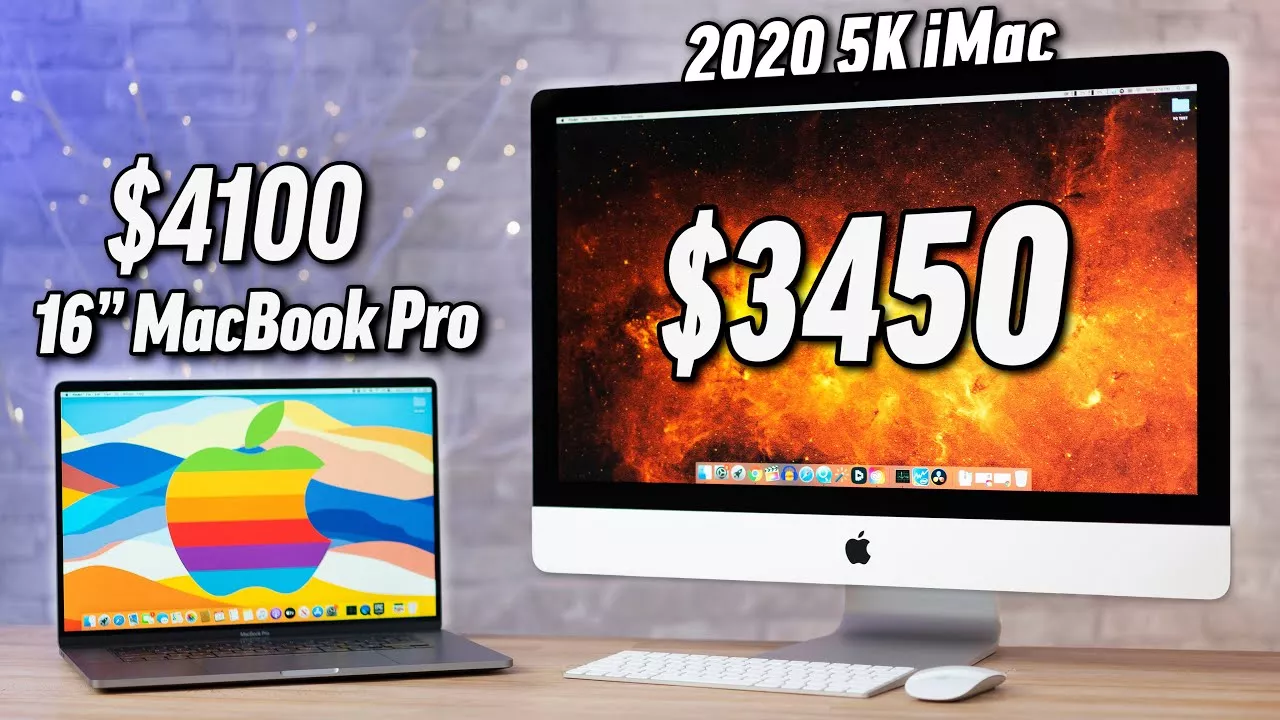

No comments yet